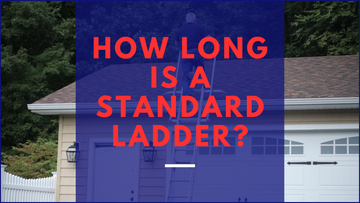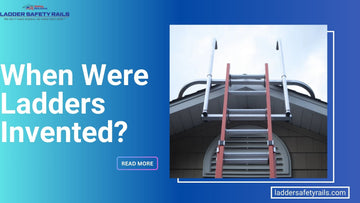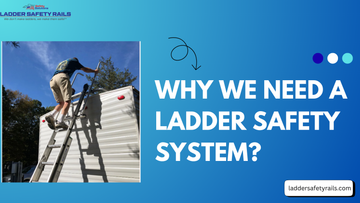
Whether you’re tackling a DIY project at home or embarking on a full-blown renovation, choosing the right ladder is a game changer. But where do you start? It all begins with understanding how long is a standard ladder.
A standard ladder doesn't mean the same thing for everyone. For some, it’s a 6-foot stepladder for indoor use; for others, it’s a 24-foot extension ladder used for roofing.
So, let’s break down ladder sizing, standard heights, and how to make the smartest, safest choice.
Understanding Ladder Sizing
Ladder sizing isn’t just about the number on the label. A 12-foot ladder doesn't give you 12 feet of working height. There are key differences between ladder length, usable height, and maximum reach. And yes, safety plays a huge part in how that’s calculated.
Here’s how ladder height terminology breaks down:
-
Ladder Height: The actual physical length of the ladder from base to top.
-
Reach Height: How high you can safely work from the ladder.
-
Maximum Standing Level: The highest safe step or rung you can stand on.
For example, with a 12 footstep ladder, the highest safe standing level is typically about 9 feet. If you’re 5'9", your reach might extend to 13-14 feet. But you shouldn’t be on the top step. Always follow the manufacturer’s guidelines—because falling from 12 feet? Not fun.
With extension ladders, things get trickier. You have to account for overlap between the sections and the setup angle, which is typically 75 degrees. That means a ladder 24 ft long won’t actually give you 24 feet of reach.
Common Step Ladder Sizes
Step ladders are a go-to for indoor and light-duty tasks. They’re freestanding, portable, and incredibly versatile. From a ladder 5 ft tall to a towering 16-footer, step ladders suit everything from changing light bulbs to hanging drapes on vaulted ceilings.
Common Step Ladder Sizes Include:
|
Ladder Height
|
Max Standing Height
|
Max Reach
|
Ideal Use
|
|
4 ft
|
2 ft 10 in
|
8 ft
|
Closets, pantry work |
|
6 ft
|
4 ft 10 in
|
10 ft
|
Painting, window cleaning |
|
8 ft
|
6 ft 10 in
|
12 ft
|
Indoor ceilings
|
|
12 ft
|
10 ft 10 in
|
16 ft
|
Exterior lights, ceiling fans
|
|
16 ft
|
14 ft 10 in
|
20 ft
|
High ceilings, gymnasiums
|
Many people assume that taller is always better, but remember, the bigger the ladder, the more room you'll need to store and maneuver. A standard size ladder for most households is usually 6 to 8 feet tall.
Step ladders are commonly made of:
- Aluminum: Lightweight, weather-resistant, ideal for homeowners.
-
Fiberglass: Heavy-duty, non-conductive—perfect for electricians.
How Tall Is a Standard Extension Ladder?
When you need vertical reach, nothing beats a standard extension ladder. These are adjustable ladders made of two or more sections that slide out to extend height. They lean against a surface—usually a wall or roof edge—and require proper setup to be safe.
Moreover, it is important to consider that ladder 24 ft doesn’t let you climb to a height of 24 feet. Due to overlap and safe climbing angles, you’ll lose about 3 feet of usable height.
Standard Extension Ladder Sizes:
|
Ladder Length
|
Max Reach
|
Best For
|
|
16 ft
|
15 ft
|
Single-story roof, gutters
|
|
20 ft
|
19 ft
|
Low roof edges, small jobs
|
|
24 ft
|
23 ft |
Two-story house, roof access
|
|
28 ft
|
27 ft
|
Taller buildings, tree trimming
|
|
32–40 ft
|
31–39 ft
|
Commercial, tall trees, scaffolding access
|
If you're a homeowner, a 20–24 ft extension ladder is usually sufficient for maintenance, painting, and gutter work.
Look for key safety features like:
- Rope & pulley system: Makes raising easier
-
D-shaped rungs: Provide better footing
-
Slip-resistant feet: Stability on multiple surfaces
-
Locking rung latches: Secure each section in place
What’s Considered a Standard Size Ladder?
The idea of a "standard" ladder varies by usage. But based on market demand and safety guidelines, some sizes stand out according to industry norms:
Standard Ladder Sizes for Homeowners:
-
6 ft Step Ladder – Ideal for most interior ceilings
-
8 ft Step Ladder – Great for exterior fixtures
-
16–20 ft Extension Ladder – Useful for 1-story homes
Standard Ladder Sizes for Professionals:
-
12 ft Step Ladder – Common on construction sites
-
24 ft Extension Ladder – Used for 2-story homes
-
32 ft Extension Ladder – For commercial use and tall access points
Standard ladder sizing also depends on the duty rating, which defines the max weight the ladder can safely hold.
Duty Ratings:
|
Rating
|
Weight Capacity
|
Usage Type
|
|
Type III
|
200 lbs
|
Light-duty
|
|
Type II
|
225 lbs
|
Household/painting
|
|
Type I
|
250 lbs
|
Commercial tasks |
|
Type IA
|
300 lbs
|
Heavy-duty
|
|
Type IAA
|
375 lbs
|
Industrial |
Choosing a standard size ladder that matches your project ensures both safety and comfort. Don’t try to force a 6-foot ladder into a job that really needs a 12-footer.
Choosing the Right Ladder Height for the Job
Getting the right height is not only about convenience, it’s about safety. Too short, and you’ll overreach (a major cause of ladder accidents). Too tall, and maneuvering becomes clunky or unsafe.
Ladder Height Selection by Task
|
Task
|
Suggested Ladder Type |
Suggested Size
|
|
Painting 8 ft walls
|
Step Ladder |
5–6 ft
|
|
Changing ceiling light (10 ft)
|
Step Ladder
|
6–8 ft
|
|
Cleaning single-story gutters
|
Extension Ladder
|
16–20 ft
|
|
Accessing two-story roof
|
Extension Ladder |
24 ft
|
|
Trimming trees
|
Extension or Orchard Ladder
|
24–28 ft
|
It’s also worth mentioning: step ladders offer working height that’s higher than you might think, while extension ladders provide vertical access but require anchoring and the correct angle (the 4:1 rule).

Conclusion:
There’s no single answer to what makes a ladder “standard”—it all depends on the job at hand. From 6-foot stepladders for everyday indoor tasks to 24-foot extension ladders for higher reaches, knowing the right size for your needs is essential.
More importantly, pairing the correct ladder with proper ladder safety practices ensures not just efficiency, but peace of mind on every project.
Stay secure on every climb—explore expert tips and tools at Ladder Safety Rails, and learn how to choose the right ladder, follow proper sizing charts, and avoid common risks. Your safety is worth it!
FAQs:
Q: What ladder size do I need?
That really depends on what you’re trying to do! For indoor jobs like changing a lightbulb or painting a room, a 6 or 8 ft step ladder usually does the trick. But if you’re working outside you’ll want something taller, like a ladder 24 ft extension model.
Q: How long of a ladder do I need to reach 20 feet?
To reach 20 feet safely, you’ll need a 24-foot extension ladder. That might sound longer than you expected, but here’s the deal: extension ladders lose a few feet to overlap and setup angle. So if you go with a 20-footer, you might come up short—literally. Always aim for a ladder that’s 3–4 feet taller than your target height.
Q: What size ladder for 10 ft ceiling?
For a standard 10-foot ceiling, a 6-foot step ladder is usually perfect. It gives you enough reach without making you climb too high. If you’re a bit shorter or want extra wiggle room, an 8-footer works great too. Just remember—never stand on the top step unless the manufacturer says it’s safe.
Q: What size ladders do roofers use?
Roofers are all about the right tool for the job. For one-story homes, they often use 20-foot ladders. But for anything taller, especially two-story houses, they’ll break out a ladder 24 ft or even a 28-footer.
Q: What height ladder do I need for a 2 story house?
Most two-story homes call for a 24 ft extension ladder. That gives you enough height to reach the upper gutters or roofline, plus an extra 3 feet to extend past the edge for safe climbing.
Read More Blogs:
 Ladder Safety Training, Why it's Important?
Ladder Safety Training, Why it's Important?






